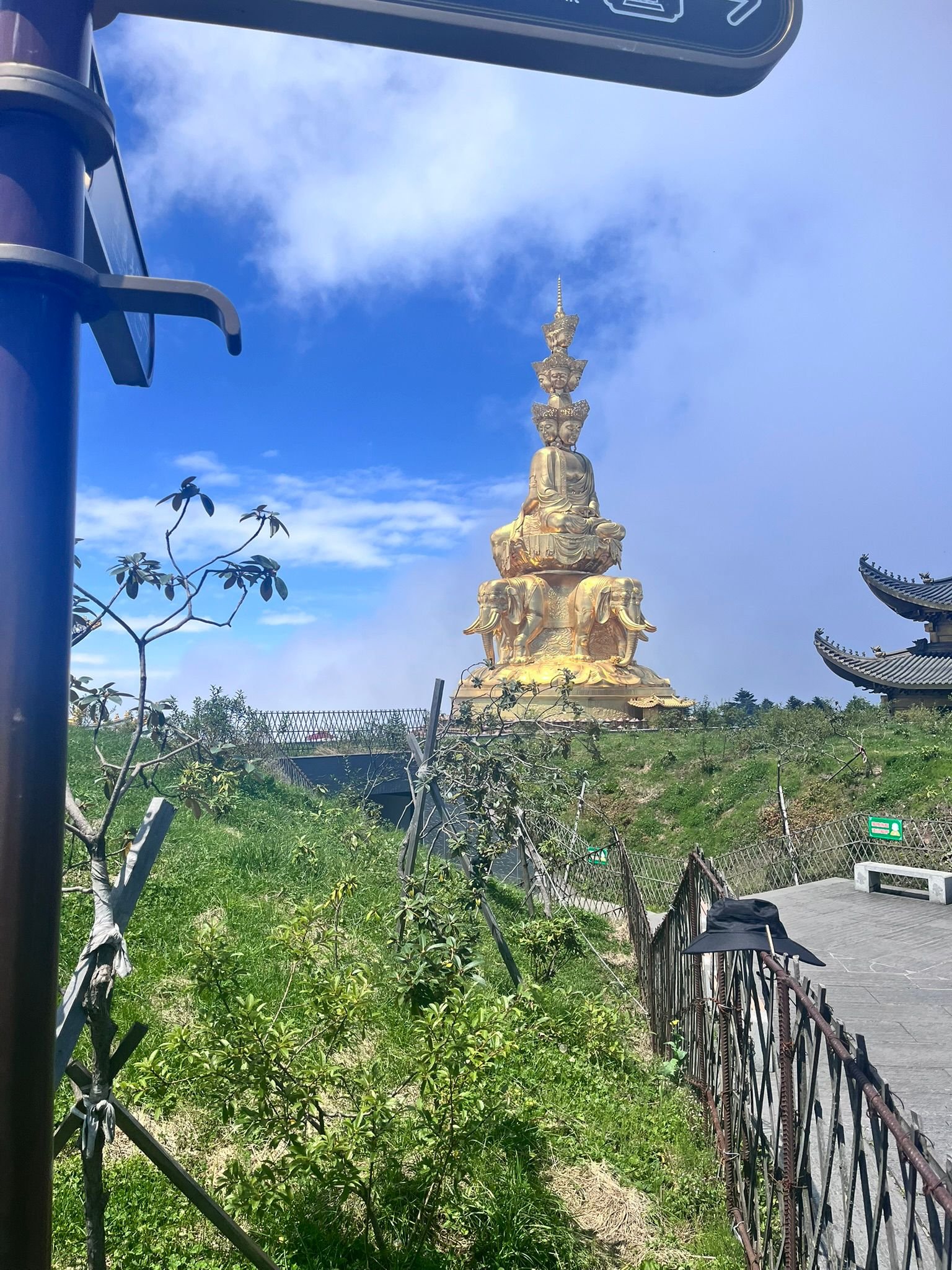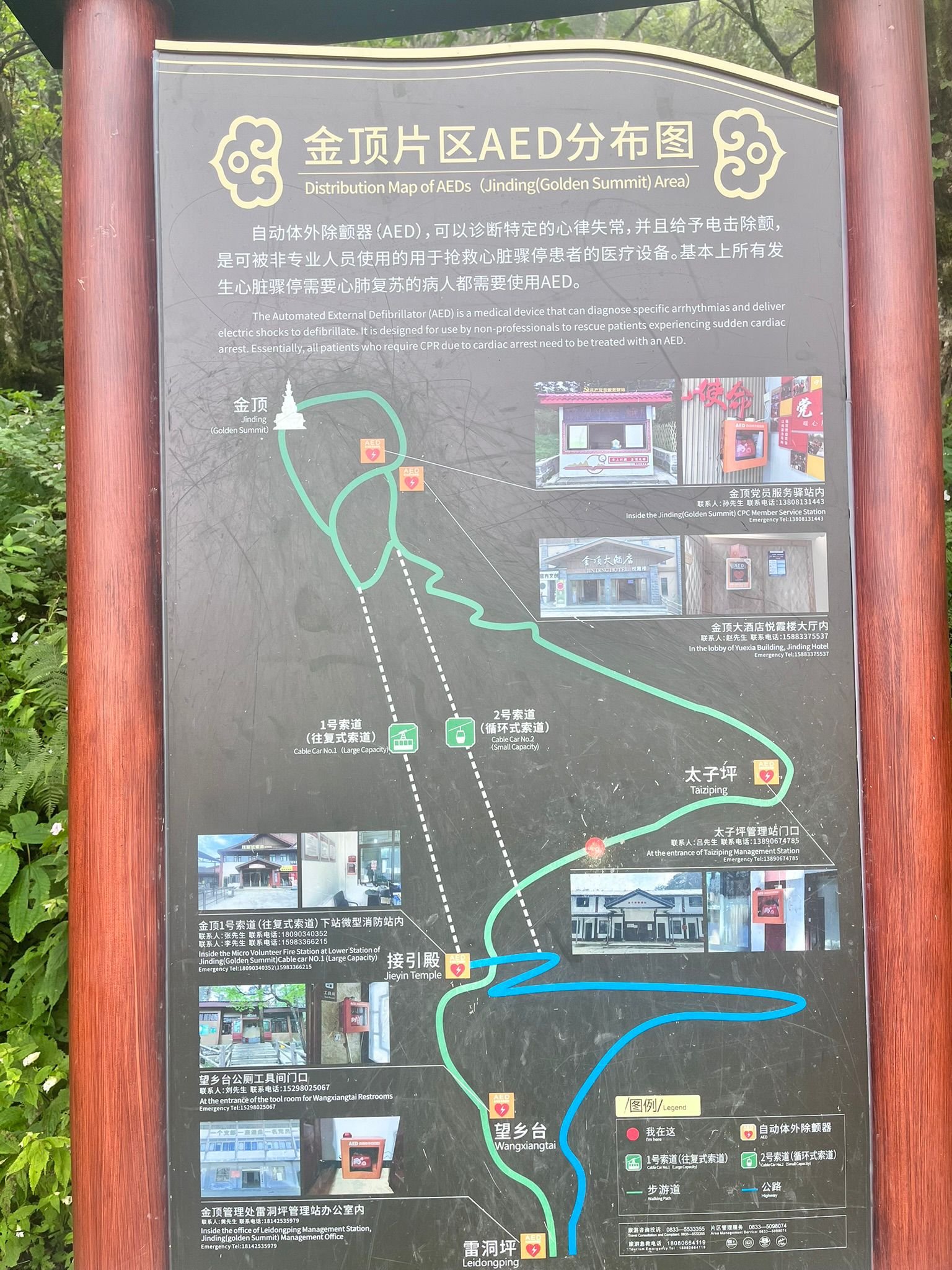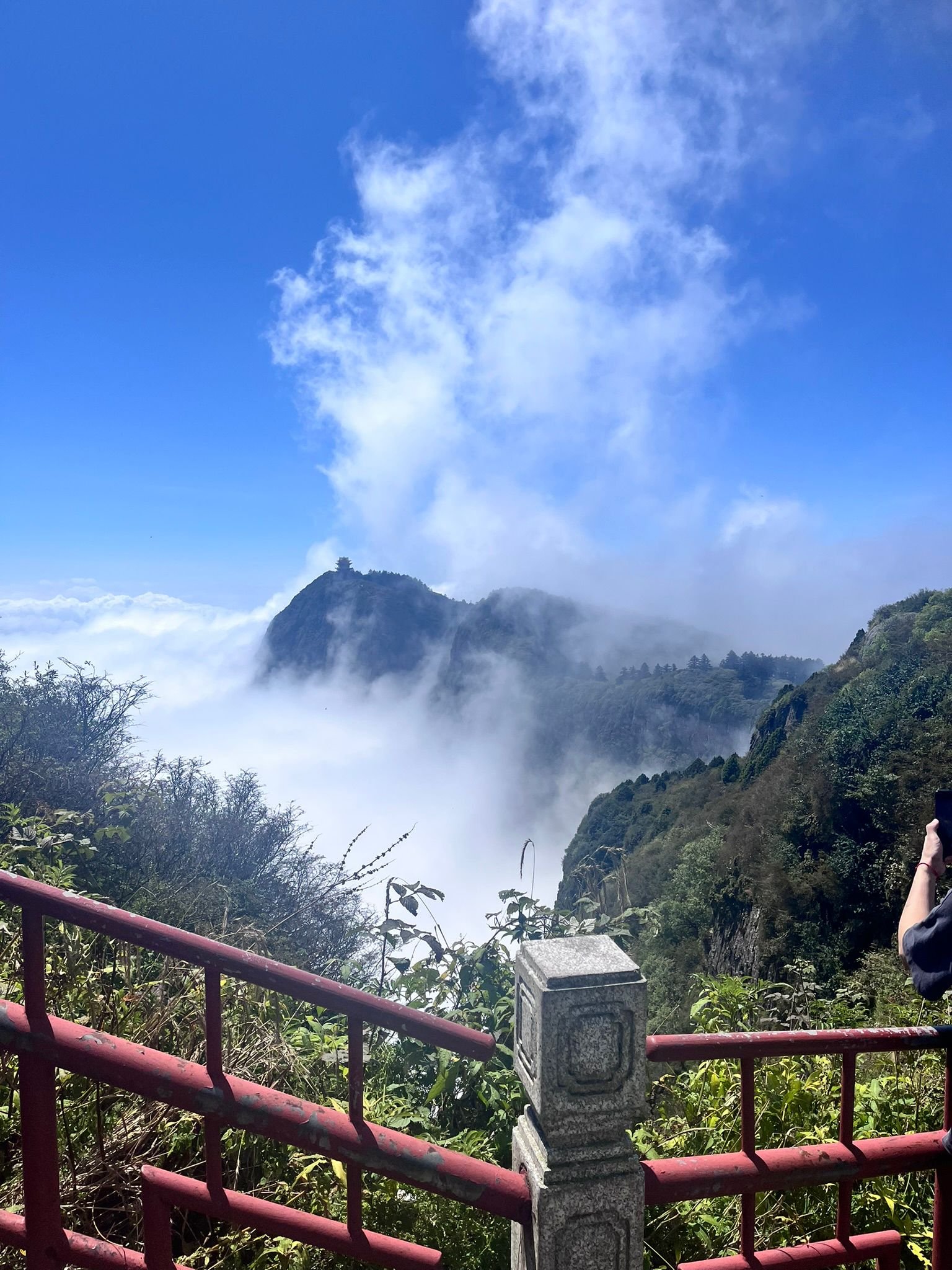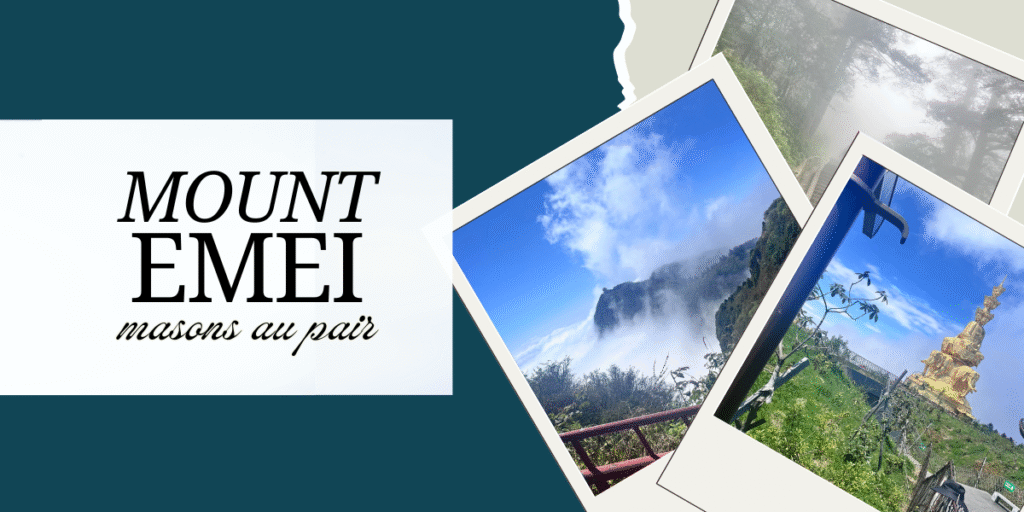Mount Emei (Emeishan, 峨眉山), located in Sichuan Province, is one of the most iconic cultural, spiritual, and natural landmarks in China. Rising to 3,099 meters, it is celebrated as a UNESCO World Heritage Site and belongs to the Four Sacred Buddhist Mountains of China, famous for their ancient monasteries, breathtaking landscapes, and deep religious significance. With its blend of temples, statues of Bodhisattvas, lush valleys, and panoramic views, Mount Emei has been a center of Buddhist practice and enlightenment for over 1,600 years.
For au pairs in China, international students, and travelers joining cultural exchange programs, a journey to Mount Emei offers much more than sightseeing. It is an opportunity to immerse yourself in Chinese Buddhism, walk among historic Buddhist temples and relics, connect with local traditions, and practice mindfulness in a truly sacred environment—all while enjoying an unforgettable adventure in the heart of Sichuan.
History and Cultural Significance
Mount Emei has been a sacred center of Buddhism for nearly two millennia. As early as the 1st century AD, monks and pilgrims traveled along its steep paths to worship, study sutras, and meditate in search of enlightenment. During the Tang dynasty, the mountain flourished as a hub of Mahayana Buddhism, attracting scholars, monks, and nuns who established temples and carved statues of the Bodhisattva Samantabhadra (Puxian, 普贤菩萨)—the spiritual guardian of Emeishan.
Today, Mount Emei is home to more than 30 active Buddhist temples and monasteries, each preserving unique relics, rituals, and teachings of the Dharma:
Baoguo Temple (报国寺): Situated at the mountain’s base, it serves as the main gateway and a place where pilgrims prepare for their spiritual journey.
Wannian Temple (万年寺): Famous for its ancient bronze statue of Samantabhadra and its tranquil, monastic atmosphere.
Golden Summit (金顶, Jinding): The highest point of Emeishan and its spiritual heart, offering panoramic views, monumental Buddhist statues, and the mystical “sea of clouds.”
Buddhist culture on the mountain is not just historical but alive and vibrant. Visitors can join monastic ceremonies, observe chanting of sutras, light incense at shrines, and engage with Buddhist monks and nuns who continue centuries-old traditions of meditation, mindfulness, and Dharma practice.

Hiking Routes and Experiences
Hiking on Mount Emei is an experience that combines physical challenge, natural beauty, and spiritual reward.
🌿 Popular Routes
Full Hike (2–3 days)
Starts at Baoguo Temple.
Stops at Qingyin Pavilion, Wannian Temple, and various scenic waterfalls.
Ends at the Golden Summit.
Perfect for those seeking a true pilgrimage experience.
Short Hike + Cable Car
Ideal for students, au pairs, or those with limited time.
Combine bus rides and cable cars with short walks to reach key highlights.
🌄 What to Expect on the Trail
Dense forests filled with exotic plants.
Waterfalls and rivers creating a refreshing atmosphere.
Stone steps and traditional architecture along the way.
Opportunities to meet pilgrims, monks, and fellow travelers.

The Famous Mount Emei Monkeys
One of the most unique and entertaining attractions of Mount Emei is its lively population of wild Tibetan macaques (Macaca thibetana). These monkeys have lived in the forests and valleys of this sacred mountain for centuries, often interacting with monks, pilgrims, and travelers. They are fascinating to observe in their natural habitat, but also known for their bold behavior and curiosity.
🐒 Tips for interacting with the monkeys:
Avoid carrying visible snacks or plastic bags—the macaques quickly associate them with food.
Keep your phone, camera, and small items safe, as the monkeys may try to snatch them.
Stay calm and observe quietly. They are a playful yet symbolic part of the Emeishan experience.
Respect their role within the local ecosystem and biodiversity—they are protected as part of the mountain’s natural heritage.
For au pairs, international students, and cultural exchange travelers, encountering the Tibetan macaques is more than just fun—it is a chance to experience China’s wildlife and natural reserves up close, while walking along the same forest trails where monks once practiced meditation and recited sutras.
The Golden Summit (Jinding)
The Golden Summit (Jinding, 金顶) is the spiritual and visual highlight of Mount Emei. Standing majestically at 3,099 meters above sea level, it overlooks the vast Sichuan Basin and surrounding snow-capped mountains of the Tibetan Plateau. For centuries, this summit has been a sacred pilgrimage site, where monks, nuns, and emperors alike traveled to seek enlightenment, dharma teachings, and spiritual renewal.
✨ Key Highlights of the Golden Summit
Samantabhadra Bodhisattva Statue (普贤菩萨像): An immense golden statue seated on a lotus throne, symbolizing wisdom, compassion, and the Mahayana Buddhist path. This figure is deeply revered across East Asia and represents the guardian of Emeishan.
Sea of Clouds (云海): A natural wonder where endless layers of clouds form a mystical “white ocean” below the peak, giving visitors the impression of standing in a pure land realm beyond the ordinary world.
Sunrise & Sunset: Pilgrims and travelers often wake before dawn to witness the sacred sunrise, when golden light illuminates the temples and statues. Sunsets, with their fiery glow, are equally celebrated for their spiritual energy and atmosphere of meditation.
Buddhist Light (佛光): A rare and awe-inspiring phenomenon where sunlight refracts through mist, creating rainbow-like halos around the observer’s shadow. Many pilgrims regard this as a divine blessing or sign of spiritual awakening.
To stand at the Golden Summit is to experience a moment where nature, religion, and human devotion converge. The combination of panoramic views, ancient rituals, chanting monks, and breathtaking natural phenomena makes it one of the most life-changing experiences in Chinese Buddhism. Visitors often describe the feeling as a deep sense of mindfulness, serenity, and transcendence that stays with them long after they leave the mountain.

How to Get to Mount Emei
Mount Emei is located near Leshan, about 150 km from Chengdu.
🚄 High-speed train: From Chengdu East Station to Emeishan Station (~1.5 hours).
🚌 Bus: From Chengdu’s Xinnanmen Bus Station (~3 hours).
🚕 Taxi/local bus: To Baoguo Temple at the foot of the mountain.
👉 Tip: Many travelers combine a visit to Mount Emei with a trip to the Leshan Giant Buddha, another UNESCO site just 30 km away.
Why Au Pairs and International Students Should Visit
For participants in an au pair program in China, as well as for international students on study abroad exchanges, a visit to Mount Emei goes far beyond simple tourism—it becomes a profound opportunity for cultural exchange and personal growth. Walking through the sacred temples and mountain trails allows young travelers to:
Learn about Chinese Buddhism and spirituality by observing rituals, chanting ceremonies, and the philosophy of compassion and mindfulness taught by monks.
Practice Mandarin Chinese in a natural setting while interacting with monks, pilgrims, and local visitors, making language learning more authentic than any classroom.
Connect with host families and fellow au pairs during a group hike, strengthening intercultural friendships and building a support network abroad.
Discover Sichuan’s cultural treasures, from temple architecture and sacred relics to the region’s legendary cuisine, while creating unforgettable memories.
Because of its accessibility from Chengdu and its unique blend of history, spirituality, and nature, Mount Emei is often considered the perfect weekend cultural trip for au pairs, exchange students, and travelers seeking to enrich their time in China with authentic immersion and adventure.
Practical Tips for Visiting
A journey to Mount Emei (Emeishan) is unforgettable, but proper preparation makes the experience even more rewarding. Here are some essential tips for au pairs, international students, and cultural travelers:
🎒 Bring warm clothes: The temperature difference between the base and the Golden Summit can be dramatic. Even in summer, the peak can be windy and chilly, so pack a jacket or layers to stay comfortable.
🥾 Wear comfortable hiking shoes: Expect long staircases, steep trails, and uneven paths. Good footwear will make your pilgrimage or hike much more enjoyable.
🍜 Try local Sichuan food: After a long day of climbing, nothing beats enjoying authentic Sichuan cuisine—from spicy hotpot to temple-style vegetarian meals prepared by monks. It’s part of the cultural immersion.
🛏️ Stay overnight in a temple: Spending a night in a monastery offers a rare chance to experience monk life, morning chanting, meditation, and Buddhist vegetarian dining—a deeper dive into spiritual traditions.
📷 Capture the magic: The mountain offers endless photography opportunities—sunrise above the Sea of Clouds, ancient temples hidden in mist, playful Tibetan macaques, and panoramic views of the Sichuan Basin.
By following these tips, travelers can enjoy not only the natural beauty of Emeishan but also its religious rituals, cultural treasures, and authentic hospitality, making the visit a true immersion into Chinese heritage.
FAQ
Where is Mount Emei located?
Mount Emei is in Sichuan Province, China, near the city of Leshan and about 150 km from Chengdu.
Why is Mount Emei famous?
It is one of the Four Sacred Buddhist Mountains of China, a UNESCO World Heritage Site, and home to Golden Summit, ancient temples, and wild monkeys.
How difficult is the hike?
The full hike can take 2–3 days and is physically challenging, but visitors can also take buses and cable cars for a lighter experience.
Can au pairs and international students visit easily?
Yes! From Chengdu, trains and buses make it very accessible. It’s a perfect cultural trip for au pairs and students in Sichuan.
What is the best time to visit Mount Emei?
Spring (April–May): Flowers in bloom.
Autumn (September–October): Clear skies and cooler weather.
Winter: Snow adds magic but requires warmer clothing.
Is it safe to visit Mount Emei?
Yes, but be careful with the monkeys, prepare for steep steps, and bring proper gear for changing weather.
What else can I visit nearby?
The Leshan Giant Buddha, the world’s largest stone Buddha, is only 30 km away and often combined with Mount Emei in one trip.
What role does Mount Emei play in the history of Buddhism in China?
Mount Emei has been a major center of Mahayana Buddhism since the 1st century AD. It is strongly associated with the bodhisattva Samantabhadra (Puxian, 普贤菩萨) and has hosted monks, nuns, and practitioners studying sutras, Buddhist teachings, and philosophy for centuries.
Which Buddhist traditions are represented on Mount Emei?
The mountain reflects a rich mix of traditions: Chinese Mahayana, influences from Tibetan Buddhism and Vajrayana, as well as elements of Zen (Chan Buddhism) and Theravada teachings. This diversity makes Emeishan a living example of Buddhist studies and practice.
What is the significance of the Samantabhadra Bodhisattva statue at the Golden Summit?
The massive golden statue represents wisdom, compassion, and enlightenment. In Mahayana philosophy, Samantabhadra embodies the practice of vows, rituals, and Dharma—guiding practitioners toward the truths of Buddhism and the Eightfold Path.
Can visitors learn about Buddhist philosophy and doctrines on Mount Emei?
Yes. Monks and nuns in the monasteries share teachings on karma, rebirth, mindfulness, and the Four Noble Truths. Visitors can attend chanting ceremonies, study Buddhist scriptures, and experience Zen meditation practices.
What is the Sangha community like on Mount Emei?
The mountain is home to an active Sangha of monks, nuns, and disciples dedicated to preserving Buddhist rituals and scriptures. Visitors may observe their daily life—morning chanting, meditation, and vegetarian meals rooted in Buddhist doctrine and discipline.
How does Tibetan Buddhism influence Mount Emei?
Though primarily a Mahayana site, Mount Emei has long interacted with Tibetan Buddhism. Pilgrims from Tibet brought tantric rituals, Vajrayana practices, and relics that enriched the local traditions and created a unique fusion of Buddhist culture.
Conclusion
Mount Emei (Emeishan) is a place where nature, spirituality, and Chinese culture come together. Whether you are an au pair in China, an international student, or a curious traveler, visiting this sacred mountain will be one of the most meaningful experiences of your journey abroad.
👉 Don’t miss the chance to hike through ancient temples, meet wild monkeys, and witness the Golden Summit sunrise—a memory that will last forever.

